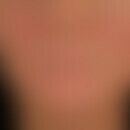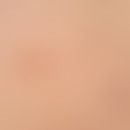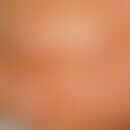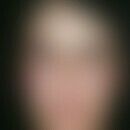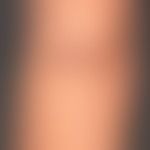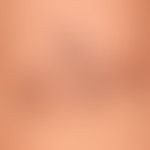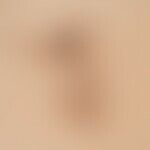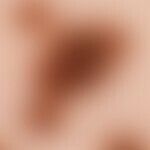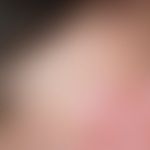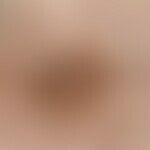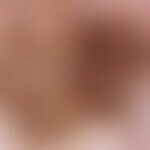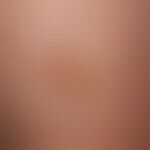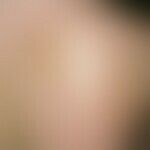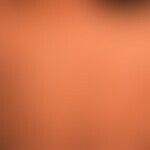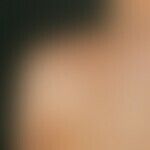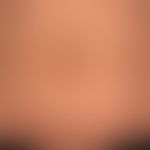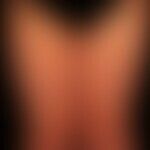Synonym(s)
HistoryThis section has been translated automatically.
Burkley, 1842
DefinitionThis section has been translated automatically.
A sharply defined, irregularly shaped, usually lentil- to palm-sized, milk-coffee-brown spot with small brown or also black-brown injections (also Kiebitzei nevus), which is already present at birth. The latter often develop only in the course of the first years of life.
You might also be interested in
LocalizationThis section has been translated automatically.
Trunk, extremities. 1 case of oral nevus spilus has been reported (Torres KG et al. 2017).
ClinicThis section has been translated automatically.
Already present at birth (often overlooked), sharply defined, irregularly shaped, usually 0.4-10.0 cm large, milky coffee-brown patch with small dark brown, splatter-like spots, which often only develop during the first years of life.
In the course of life, the initially rather discrete splashes can transform into clearly defined black-brown papules, giving this nevus variant its typical aspect.
In rare cases, the development of malignant melanomas is observed in a nevus spilus. In this respect, the nevus spilus requires regular clinical monitoring.
Speckled lentiginous nevus syndrome is a cutaneous phenotype with nevus spilus (speckled lentiginous nevus) with hyperhidrosis, muscle weakness, dysesthesia or other neurological abnormalities.
Phacomatosis spilorosea (Happle 2005) is characterized by the combination of a naevus spilus with a naevus roseus, a capillary hamartoma, which was previously referred to as naevus flammeus lateralis.
Phacomatosis pigmentokeratotica (Happle 1996) is characterized by the combination of a nevus spilus with a nevus sebaceus.
HistologyThis section has been translated automatically.
Differential diagnosisThis section has been translated automatically.
The nevus spilus resembles the cafe-au-lait stain, but differs from it in the dark indentations in the underlying brown stain. The term "lapwing egg naevus "describes this aspect very well.
Becker ne vus: This nevus is not congenital, usually develops postpubertally (androgen dependence?) and shows hypertrichosis in addition to a broken reticulated border.
TherapyThis section has been translated automatically.
Annual inspection. Excise conspicuous, injected nevi early, as the danger of degeneration cannot be completely negated. If necessary, cosmetic cover with e.g. Dermacolor.
Note(s)This section has been translated automatically.
"spilus" = speckled
The lapwing is a bird whose eggs have a conspicuous mottle. The name is most likely derived from these.
LiteratureThis section has been translated automatically.
- Breitkopf CB et al (1996) Neoplasms on nevus spilus. Dermatologist 47: 759-762
- Cramer SF (2001) Speckled lentiginous nevus (nevus spilus): the "roots" of the "melanocytic garden". Arch Dermatol 137: 1654-1655
- Happle R (2002) Speckled lentiginous nevus syndrome: delineation of a new distinct neurocutaneous phenotype. Eur J Dermatol 12: 133-135.
- Mang R et al (2003) Unusual clinical presentation of melanocytic nevi. Dermatologist 54: 370-372
- Ramolia P et al (2009) Speckled lentiginous nevus syndrome associated with musculoskeletal abnormalities. Pediatr Dermatol 26: 298-301
- Sarin KY et al (2014) Activating HRAS mutation in nevus spilus. J Invest Dermatol 134:1766-1768.
- Schaffer JV et al (2001) Speckled lentiginous nevus: within the spectrum of congenital melanocytic nevi. Arch Dermatol 137: 172-178
- Tavoloni Braga JC et al (2014) Early detection of melanoma arising within nevus spilus. J Am Acad Dermatol 70:e31-e32
- Torres KG et al (2017) Nevus spilus (Speckled Lentiginous Nevus) in the Oral Cavity: Report of a Case and Review of the Literature. Am J Dermatopathol 39:e8-e12.
Incoming links (16)
Atrophodermia idiopathica et progressiva; Café-au-lait stain; Eccrine angiomatous hamartoma; Giant melanosome; Lapwing-naevus; Lentigo simplex; Mosaic cutaneous; Naevus; Naevus melanocytic common; Naevus-spilus-papulosus syndrome; ... Show allOutgoing links (7)
Becker's nevus; Café-au-lait stain; Camouflage; Hyperpigmentation; Lentigo simplex; Nevus melanocytic (overview); Nevus sebaceus;Disclaimer
Please ask your physician for a reliable diagnosis. This website is only meant as a reference.
